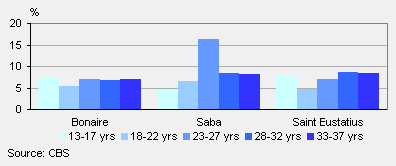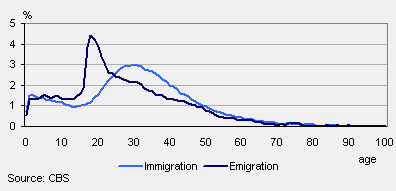18 thousand Dutch Caribbeans

Since 10 October 2010, the Caribbean islands of Bonaire, Saba and Saint Eustatius have officially acquired the status of Dutch municipalities. As a result, 18 thousand new citizens were added to the Dutch population. The name Dutch Caribbean was bestowed on the new Dutch territory.
Young population
The average age of the new residents is 35.7 years. They are on average 4.4 years younger than people living in the Netherlands. The most substantial difference is recorded in the proportion of older people in both populations: fewer than 9 percent of the Dutch Caribbean population are 65 years of age or older versus more than 17 percent of the Dutch population in Europe. The marginally higher number of Dutch Caribbean children and the significantly lower life expectancy of Dutch Caribbean men partly account for the difference.
Age categories in the Dutch Caribbean population

Few residents around the age of 20
Young adults are relatively rare on the islands of Bonaire and Saint Eustatius. This is probably due to many young people having moved to the Netherlands to work or study. Saba, on the other hand, has a relatively high number of people in their early twenties due to the presence of the Saba University Medical School, which attracts many foreign students.
Young adults by age, 1 January 2010

Massive migration flows
Over the past five years, immigrants outnumbered emigrants on Bonaire. With respect to Saba and Saint Eustatius, emigration and immigration were virtually equal. Approximately 40 percent of migrants from Bonaire were destined for the Netherlands, whereas for most migrants from Saba and Saint Eustatius, the United States and Canada are the most important countries of destination. Many emigrants are aged between 18 and 23, the peak for immigrants is around 30. Apparently, at least part of emigrants eventually return to their country of origin.
Migration to and from the Dutch Caribbean by age

Carel Harmsen and Menno ter Bals